A Study of Water Quality in Kelly’s Off Stream Storage, Byfield, Central Queensland
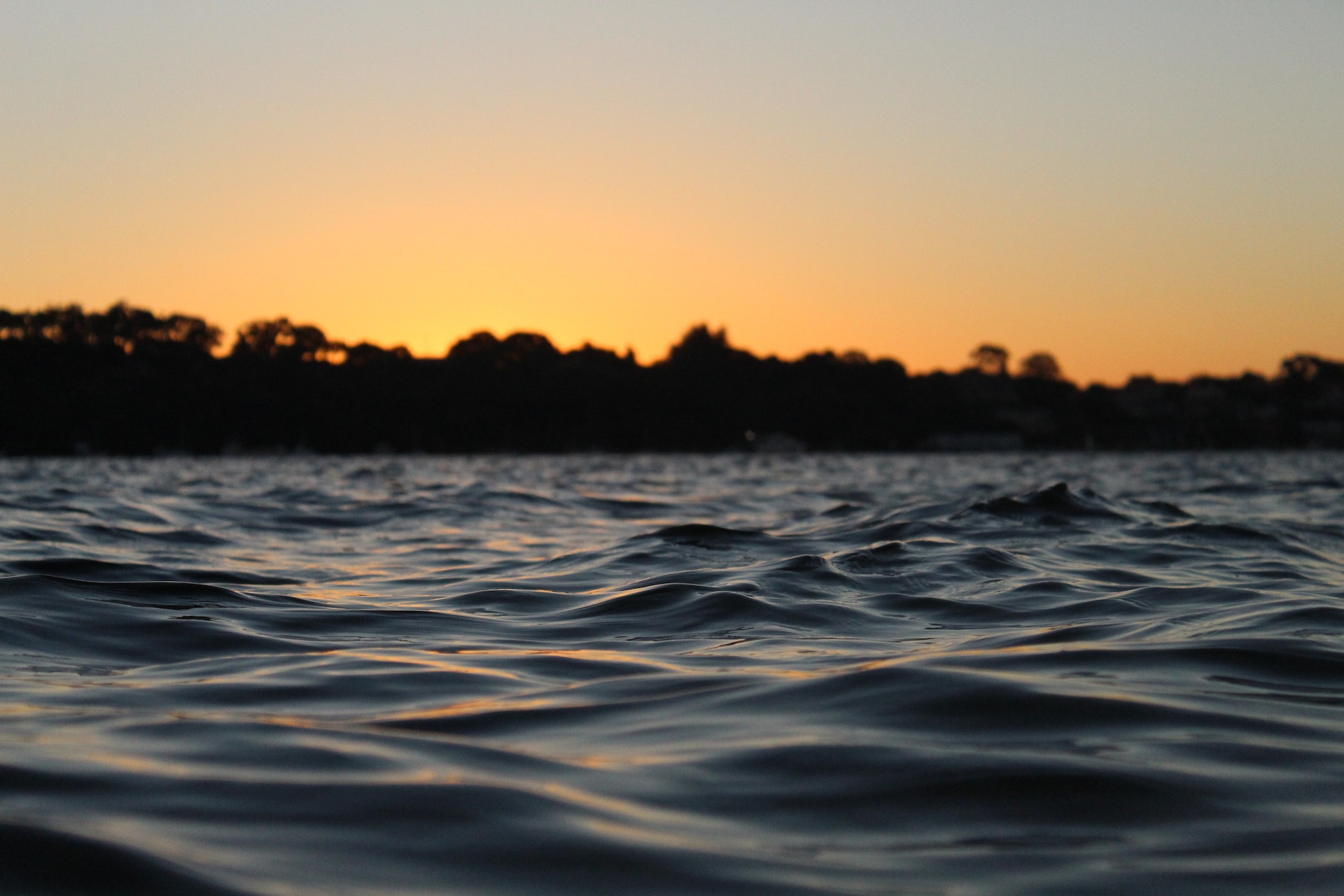
DOWNLOAD THE PAPER
Abstract
This paper analyses the water quality and environmental determinants for Kelly’s Off Stream Storage, Byfield, Central Queensland with a view to understanding the physical and chemical processes in this section of the water supply system. This assists management in evaluating risks and the need for preventative actions. It illustrates the link between a protected and well vegetated catchment and a high quality and good tasting water supply. The drinking water from the treatment plant associated with this Off Stream Storage has won many awards in taste tests. Key to the quality of this water is the sand filtration in the dunes upstream from Water Park Creek, quality of the catchment, riparian vegetation in the source stream, the pattern of stratification and mixing, conductivity and low concentrations of nutrients.
Introduction
The site for this study was Kelly’s Off Stream Storage, Byfield, 19 km north of Yeppoon, Central Queensland, Australia (Figure 1) also referred to as Kelly’s Dam. Water is pumped from Water Park Creek into this Off Stream Storage and from the storage to the Livingstone Shire Council’s Woodbury Water Treatment Plant. At the plant, water is conventionally treated with coagulation, flocculation, clarification, filtration, and disinfection by chlorination. Water from this plant has won the Ixom Best of the Best Queensland Water Taste Test 2017, the Sigura Best of the Best Queensland Water Taste Test and the Water Industry Operators Association Ixom Water of Origin Taste Test 2021. This treatment plant supplies potable (drinking) water to the Capricorn Coast.
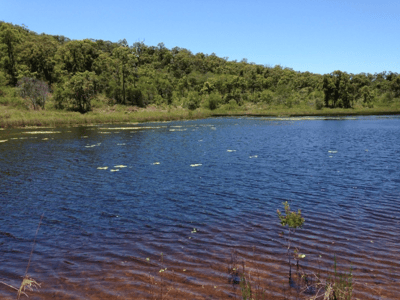
Figure 1: A photograph of Kelly’s Off Stream Storage, Byfield illustrating the clarity of the water column and the vegetated catchment.
Kelly’s Off Stream Storage is unusual compared to most dams in that although a referable dam it has a very small catchment of less than 65 Ha in total, including a water surface area of approximately 18.2 Ha at full supply level.
Water Park Creek (Figure 2) originates in the Ramsar listed wetlands of Corio Bay, in particular, in freshwater lenses in the sand of the Dismal Swamp. Water is naturally sand filtered in this region and then flows downstream through Water Park Creek into Corio Bay and the Great Barrier Reef Lagoon. The creek flows through the Byfield National Park, and areas outside of the national park are used predominately for forestry and low intensity grazing. The catchment around Kelly’s Off Stream Storage itself is bushland with no human development.
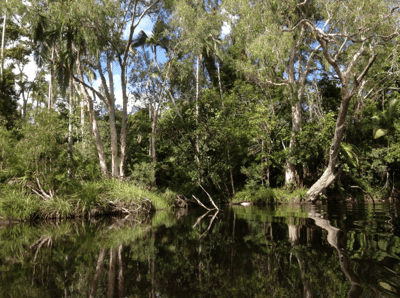
Figure 2. Water Park Creek, Byfield National Park showing the water column characteristics and surrounding vegetation.
Method
In situ water quality
Transects of Kelly’s Off Stream Storage were undertaken between December 2017 and July 2019. Water column depth profiles were undertaken at three sites in the Off Stream Storage (Figure 3). Measurements were recorded in triplicate throughout the depth profile at each site using a calibrated YSI EXO 2 water quality instrument (YSI and Xylem Incorporated, Ohio, USA) or a calibrated YSI water quality meter (6600V2-02 Sonde and 650 MDS handheld; YSI and Xylem Incorporated, Ohio, USA) and included temperature (°C); conductivity (µS/cm); dissolved oxygen (% Saturation); pH; oxidation reduction potential (mV) and turbidity (NTU or FNU). Results reported were the average of three field recordings at that particular location and depth.
Figure 3. Aerial view of Kelly’s Off Stream Storage, Byfield with pink pins showing the three sites used for monitoring of water quality between 18 December 2017 and 30 July 2019. Inserts show the position of Yeppoon and that of Kelly’s Offstream Storage. The WTP site is near the offtake pipe for the Woodbury Water Treatment Plant.
Chemical Analyses
Samples were collected from Kelly’s Off Stream Storage for total and dissolved nutrients. Dissolved forms were field filtered using a 0.45 µS/cm cellulose acetate filter and all samples were transported on ice to the Livingstone Shire Council chambers in Yeppoon. There, the samples for Ultra-trace Nutrients were frozen overnight before transport to the NATA accredited ALS laboratories in Brisbane for analysis.
Livingstone Shire Council also supplied chemical data on the raw water pumped from the Off Stream Storage into the water treatment plant as well as the treated water from the plant. These were also analysed by ALS. Iron and hardness were analysed monthly whereas metals and metalloids were analysed on an annual basis. Organochlorine and organohaline pesticides were tested annually on the raw water. The treated water from the Woodbury Water Treatment Plant was analysed quarterly for trihalomethanes.
Samples were also collected for total and dissolved manganese, with the dissolved sample field filtered using a 0.45 µm cellulose acetate filter. These were transported chilled to the Central Queensland University laboratories in North Rockhampton where they were analysed using ICPMS. Data on the raw water being pumped to the Woodbury Water Treatment Plant from Kelly’s Off Stream Storage were provided by the Livingstone Shire Council.
Cryptosporidium and Giardia
Samples for Cryptosporidium and Giardia were collected on an annual basis and analysed by Queensland Health Scientific Services (QHSS), a NATA accredited laboratory.
Phytoplankton
Phytoplankton samples were collected throughout the depth profile using a van Dorn sampler or in approximately 20 m tows across the surface layer using a 25 µm plankton net. Samples were divided into two subsamples with one kept fresh and the other preserved with Lugol’s Iodine. Fresh material was photographed and identified where possible using a Nikon Eclipse Ni equipped with a Nikon 5MP Colour Camera (Nikon Instruments Inc., Japan). The preserved sample was used for further identification purposes and retained as a record.
Data Analysis
Contour plots of field data were constructed using Surfer 21 (Golden Software, Colorado, USA). Plots of other data were created using Sigmaplot 14 (Systat Software Inc., USA).
Results and Discussions
Stratification and Mixing
Kelly’s Off Stream Storage stratified during the summer months and mixed during the winter (Figure 4). Mixing was a relatively slow process from the shallow pipe end of storage to the deeper end where the Woodbury Water Treatment Plant intake pipe was located. No sudden mixing events were detected.
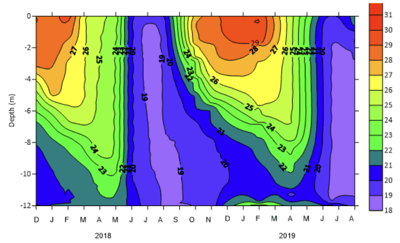
Figure 4. Isotherms of water column depth profiles recorded at the WTP site in Kelly’s Off Stream Storage, Byfield between 18 December 2017 and 30 July 2019.
Specific Conductance (Conductivity at 25°C)
The water in Kelly’s Off Stream Storage was fresh. The contour plot of the specific conductance in this storage dam also showed that chemical as well as thermal stratification was present (Figure 5). Such measures of conductivity can also be used as a surrogate for the concentration of total dissolved solids and an indicator of the level of chemical contamination of a water body.

Figure 5. Isopleths of water column depth profiles of specific conductance (µS/cm) recorded at the WTP site in Kelly’s Off Stream Storage, Byfield between 18 December 2017 and 30 July 2019.
Dissolved Oxygen
Profiles of dissolved oxygen (% Saturation) show continued oxygenation of the surface layer throughout the study, although an anoxic hypolimnion developed during the period of stratification (Figure 6). Patterns in the hypolimnion mirrored the distribution of specific conductance. The top four meters of the storage remained oxygenated throughout the year. This ensured that the offtake from the storage into the water treatment plant was always accessing an oxygenated supply of water. Knowledge of such processes was particularly useful when anticipating risks to the quality of the water supply and applicable water treatment processes.
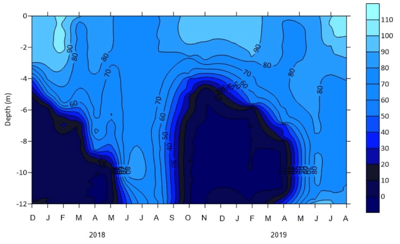
Figure 6. Isopleths of water column depth profiles of dissolved oxygen (% Saturation) recorded at the WTP site in Kelly’s Off Stream Storage, Byfield between 18 December 2017 and 30 July 2019.
Manganese
The Australian Drinking Water Guidelines (ADWG) recommend that in drinking water the concentrations of Manganese are to be below the health based guideline value (0.5 mg/L) and suggest water treatment aims to produce concentrations below the aesthetic guideline value (0.1 mg/L) (NHMRC 2011). The results for Total and Dissolved Manganese did not exceed these guidelines even in the raw water collected from the surface of Kelly’s Off Stream Storage (Figure 7). The raw water offtake from Kelly’s Offstream Storage into the Woodbury Water Treatment Plant draws water from the continually oxygenated surface layer (see Figure 6). This is critical to the rapid oxidation and low concentration of any release of dissolved manganese into the surface waters as a result of overturn or mixing. Such a situation reduces the cost of drinking water treatment.
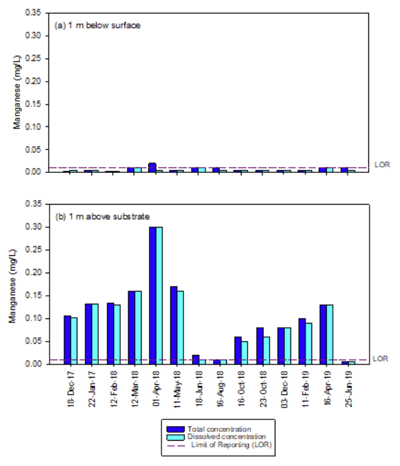
Figure 7. Total and Dissolved Manganese concentrations in samples collected (a) 1 m below the surface and (b) 1 m above the sediments in Kelly’s Off Stream Storage, Byfield between 18 December 2017 and 25 June 2019. Where concentrations were less than the Limit of Reporting (<LOR) half that LOR has been plotted.
Oxidation Reduction Potential
Negative Oxidation Reduction Potential developed in the hypolimnion during the periods of stratification and coincided with the periods of hypolimnetic anoxia and the release of dissolved manganese from the sediments (Figures 6, 7 and 8).
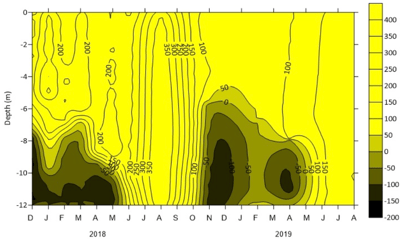
Figure 8. Isopleths of water column depth profiles of Oxidation Reduction Potential (mV) recorded at the WTP site in Kelly’s Off Stream Storage, Byfield between 18 December 2017 and 30 July 2019.
pH
Water in Kelly’s Off Stream Storage was slightly acidic (Figure 9). The humic and fulvic acids released by decomposing leaf litter in Water Park Creek would have contributed to this condition. Realizing the potential for organics in the raw water and the potential formation of halogenated disinfection byproducts in the treated water, the concentration of trihalomethanes in the treated water was analysed and ranged from 0.027 to 0.068 mg/L between February 2018 and August 2019. The ANZECC health based guideline is 0.25 mg/L (NHMRC 2011).
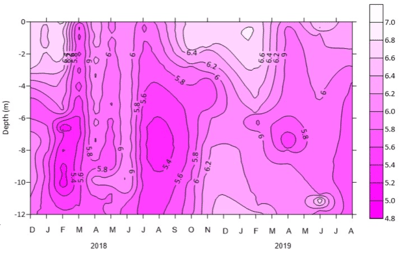
Figure 9. Isopleths of water column depth profiles of pH recorded at the WTP site in Kelly’s Off Stream Storage, Byfield between 18 December 2017 and 30 July 2019.
Turbidity
Turbidity is the result of light refracted by particles in the water column. Low turbidity is an indicator of low concentrations of particles in the water column. Very low results for turbidity were recorded in the surface waters of Kelly’s Off Stream Storage (Figure 10).
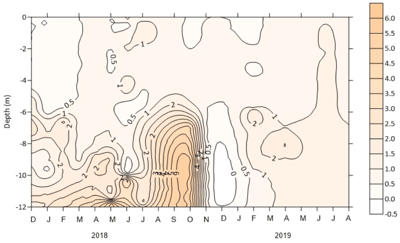
Figure 10. Isopleths of water column depth profiles of Turbidity (NTU prior to October 2019 and FNU after that) recorded at the WTP site in Kelly’s Off Stream Storage, Byfield between 18 December 2017 and 30 July 2019.
Pathogens
The oocysts of the pathogens Giardia and Cryptosporidium were not detected in the raw or treated water when annual testing was undertaken by Livingstone Shire Council at the end of the rainy season. Pathogens are considered to contribute a high level of risk to a water supply (NHMRC 2011). The ADWG note that turbidity may be used as a surrogate for a hazard such as the protozoan pathogens Cryptosporidium and Giardia (NHMRC 2011). The turbidity required for optimal disinfection of treated drinking water is <1 NTU (NHMRC 2011). Even before the water is pumped into the Woodbury Water Treatment Plant, the turbidity of the raw water in the surface layers of Kelly’s Off Stream Storage on most occasions was less than 1 NTU (or 1 FNU). This low risk relates back to the very small and protected catchment surrounding the storage itself, as well as the lack of farm animals and septic systems in the broader catchment and water source.
Nutrients
Biologically available (dissolved) nutrients in the surface waters of Kelly’s Off Stream Storage were comparatively low (Figures 11 and 12). However, a peak in ammonia as N (120 µg/L) was detected in the hypolimnetic water samples in April 2019. Most of the nitrogen in the Off Stream Storage is in the form of Total Kjeldahl Nitrogen. Hence, after subtracting the ammonia as N, the principal form of nitrogen in the Off Stream Storage was organic.

Figure 11. Total and Dissolved Phosphorus concentrations in samples collected 1 m below the surface and 1 m above the sediments in Kelly’s Off Stream Storage, Byfield between 18 December 2017 and 25 June 2019. Where concentrations were less than the Limit of Reporting (LOR) half that LOR has been plotted.
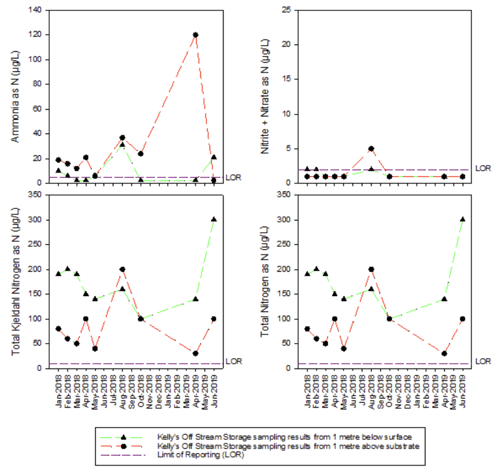
Figure 12. Total and Dissolved Phosphorus concentrations in samples collected 1 m below the surface and 1 m above the sediments in Kelly’s Off Stream Storage, Byfield between 18 December 2017 and 25 June 2019. Where concentrations were less than the Limit of Reporting (LOR) half that LOR has been plotted.
Phytoplankton
The dominant groups of phytoplankton in Kelly’s Off Stream Storage were desmids, diatoms and dinoflagellates with Staurastrum, Aulacoseira and Ceratium the most common genera. No cyanobacteria were detected. As this group contains many species which are capable of producing taste and odour problems in a water supply, the absence of these is critical in producing good tasting water (Watson et al. 2016). The presence of dinoflagellates such as Ceratium may on occasion impart a “fishy” taste and odour to a water supply, however, this was not detected during the study.
Central Queensland has a history of the presence of toxin producing cyanobacteria (Fabbro and Duivenvoorden 1996; Fabbro 1999; Humpage et al. 2012). Traditionally, stratification and a lack of flow are associated with the production of blooms of cyanobacteria (Ibelings et al. 2021). Off stream storage in coastal areas is also prone to blooms of cyanobacteria (Everson et al. 2009) as well as the off stream storage which pumps from the Fitzroy River system to Stanwell power station (Stitz et al. 2013). Even though there is no obvious flow with the presence of stratification and an anoxic hypolimnion, especially in the summer months in Kelly’s Off Stream Storage, the low nutrient conditions and slightly acidic pH coincide with a water column free of cyanobacteria. More recently, the chemical release from decaying bankside vegetation has been found to produce allelopathic compounds which decrease the growth of key problematic species of cyanobacteria (Neilen et al. 2017). Many of the phytoplankton genera present are also detected in the good quality water present in the Kakadu National Park (Ling and Tyler 1986).
Raw and Treated Water Chemistry Results from Woodbury Water Treatment Plant
Total Hardness as mg/L CaCO3 in the raw water ranged from 11 to 18 mg/L, whereas that in the treated water ranged from 32 to 47 mg/L (Figure 13). Such concentrations of hardness fall within the soft water category that may possibly be corrosive (NHMRC 2011). However, the results for the treated water are closer to the boundary of this category than those of the raw water.
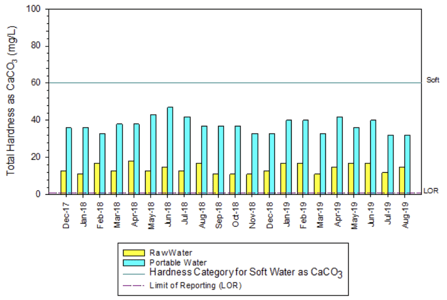
Figure 13. Total Hardness as mg/L CaCO3 analysed from samples of raw and treated water collected at the Woodbury Water Treatment Plant between December 2017 and August 2019.
Lead, Cadmium, Chromium, Nickel, Selenium and Mercury concentrations in samples collected from the Raw Water feeding from Kelly’s Off Stream Storage into the Woodbury Water Treatment Plant were below the Limit of Detection for the analysis method utilized for the sample (that is, the lowest level at which the laboratory can legally report a result) (Table 1).
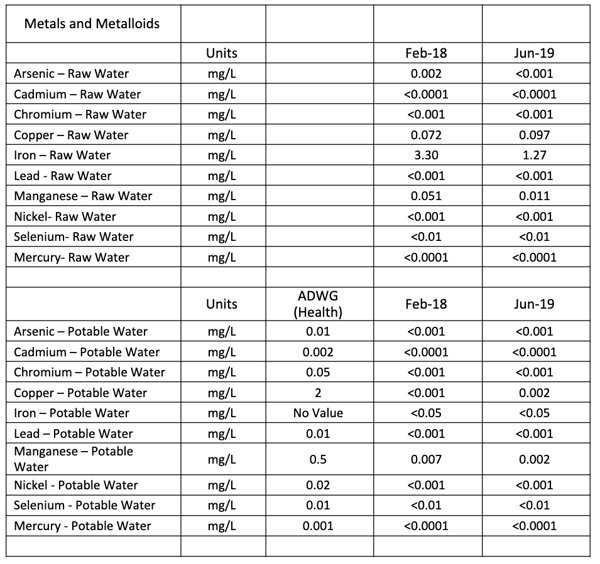 Table 1. Raw and potable (drinking) water results for selected metals and metalloids provided by the Livingstone Shire Council for samples collected at the Woodbury Water Treatment Plant on 8 February 2018 and 12 June 2019.
Table 1. Raw and potable (drinking) water results for selected metals and metalloids provided by the Livingstone Shire Council for samples collected at the Woodbury Water Treatment Plant on 8 February 2018 and 12 June 2019.
Organochlorine and organohaline pesticides were not detected in samples collected from the raw water during the period of the study.
The source of the water in the sand lenses of the Dismal Swamp provides natural sand filtration of the water. Sand filtration is a technique used internationally to remove particles and pathogens in the water treatment process. The quality of the water produced by sand filtration is then not adversely impacted as the water travels between the Dismal Swamp and Kelly’s Off Stream Storage. There is excellent riparian vegetation around Water Park Creek. Kelly’s Off Stream Storage has a catchment which is very small, not developed and well vegetated. Only native animals were present. These conditions contribute to both low turbidity and low nutrients.
The award winning taste of the water from the Woodbury Water Treatment Plant mirrors the high water quality of water in the catchment and Off Stream Storage. The absence of significant taste and odour producing cyanobacteria is also a factor. Water Quality variables recorded in the Off Stream Storage are often within the Australian Drinking Water Guidelines (NHMRC 2011) even before water goes through the drinking water treatment plant. Such catchment and storage water quality reduces the costs and concentrations of chemicals used in the treatment process. The obvious knowledge base and enthusiastic attitude of the council to achieve a high quality water supply coupled with the interest of the general public of the Capricorn Coast to see this occurring, are important in the continued maintenance of the quality of this drinking water supply.
Threats for the future of the quality of this water supply relate primarily to the quality of the catchment and any major sources of contamination or change within the Off Stream Storage itself. Whilst the storage and immediate catchment is under the direct control of the council, the areas around and within Water Park Creek, the Byfield National Park, the forestry and upstream areas under the control of the state and federal governments provide a challenge to management in terms of knowledge of impacts and generation of additional hazards.
There is normally a time lag between modifications within the catchment and changes to the quality of water within a storage. This time lag is often also seen in monitoring results from raw water dams and treatment plant intakes. It is imperative that management within the Livingstone Shire Council maintain a positive dialogue with outside activities and managers. With some areas of Shoalwater Bay at the northern extent, there is a potential for contamination with products produced by military exercises and development. With forestry activities, there is the threat of aerial spraying and application of herbicides, nutrients and pesticides. Camping, release of human and animal wastes, hydrocarbons from any fuel spills and fire are of concern in relation to the Byfield National Park. Contamination by transfer of equipment used on toxic cyanobacterial blooms in the nearby Fitzroy River system, modifications to the stratification and mixing or spill of fuel or chemicals used within the Off Stream Storage should be avoided. Awareness of potential future hazards and assessment of risks and incorporation of preventative actions is essential to good management of any water supply (NHMRC 2011).
Conclusion
This analysis of conditions in Kelly’s Off Stream Storage reiterates the importance of the management of both the catchment and the activities within the Off Stream Storage itself as part of the proactive management of a high quality water supply. Knowledge of the water column profiles of stratification and mixing within the storage can be used to anticipate potential timing of mixing of hypolimnetic water into the surface layer and accompanying potential, or lack of in this case, of manganese and increased concentrations of biologically available nutrients in the surface layer. The low specific conductance indicates low concentrations of various ions and this together with the low concentrations of nutrients are a broad indication of the lack of chemical contamination and the highly reduced possibility of cyanobacterial blooms. The evidence of organic inputs and soft water has meant incorporation of treatments that increase the hardness and decrease the potential for trihalomethanes whilst ensuring adequate disinfection of supply. Monitoring for turbidity, pathogens and cyanobacteria enables treatment mechanisms for these to be rapidly incorporated by management if necessary.
Livingstone Shire Council was aware of pertinent issues in the upper catchment and monitored to ensure the safety and quality of this water supply. It is hoped that the quality water from this relatively undeveloped and well vegetated catchment together with the protected Off Stream Storage can contribute to safe and secure drinking water supply in the future.
Acknowledgements
The authors wish to acknowledge the field assistance of Tiffany Brown. The support and assistance of the Livingstone Shire Council in particular Bill van Wees, Sean Fallis and Nige Deacon was very much appreciated. Thanks also to the Livingstone Shire Council for organizing the analysis of nutrient samples.
Author Biographies
Larelle Fabbro A.S.D.A., Dip. T., B. App. Sci. (Biol), PhD | Larelle is an Associate Professor at Central Queensland University specializing in cyanobacterial blooms and the ecology and health of rivers.
Alison Craig B.Env.Sc. | Alison graduated from CQUniversity, Rockhampton in 2012 and has worked on various aquatic ecology projects. Alison specialises in the analysis of macroinvertebrates as biological indicators of stream health and has many years of experience in field data collection and sampling of water bodies throughout central Queensland.
Geeta Gautam Kafle BSc.Ag, MASc. | Geeta has been working for the last 10 years on projects looking at the aquatic ecology and health of water bodies in the Central Queensland region. She specializes in water quality assessment, data analysis and use of multivariate techniques, report writing, macroinvertebrate identification and analysis.
Lorna Wells B. Env. Sc. | Lorna is a graduate of Central Queensland University, Rockhampton. Her Degree in Environmental Science led to an interest in freshwater algae, most notably, Staurastrum through the study at Kelly’s Dam, Yeppoon. Lorna was involved in the early field sampling and laboratory analysis of the samples.
Tania Collins | Tania was employed as a Technical Officer for Tweed Shire Council for 13 years, with experience in water, wastewater and soil analysis, ICP, ICP-MS and AAS – furnace as well as wet chemistry testing. Tania has now worked for Central Queensland University for the last 7 years.
Glenn McIntyre | Glenn has worked in Local Government as a Pest Officer for 24 years, he has a CERT III in Horticulture and Asset Maintenance. He has a detailed understanding of the environments in Livingstone Shire, and provided support with water quality monitoring and knowledge of Kelly’s Off Stream Storage.
Veikko Kunkel | Veikko is an experienced research professional with a demonstrated history of working in the higher education industry. Skilled in E-Learning, Data Analysis, Lecturing, and Educational Technology.
Michael Dalton, B. App. Sc. (Chem.), Cert IV in Water Industry Operation, Cert IV in Trade Waste and a B. Adv. Safety Management | Michael is experienced in Water Resource Management, Health and Safety, Commissioning, Water Quality, and Mining. Michael was the project manager of this work for the Livingstone Shire Council.
